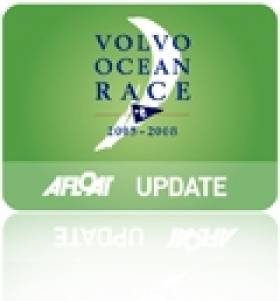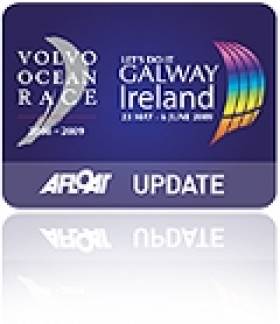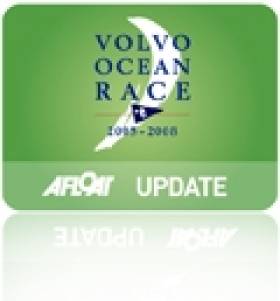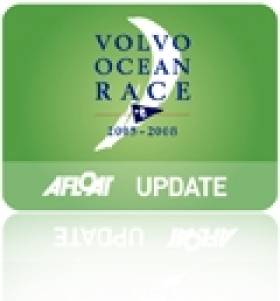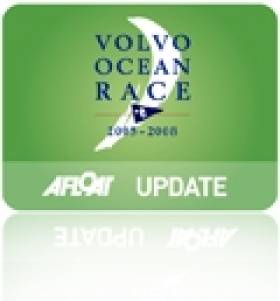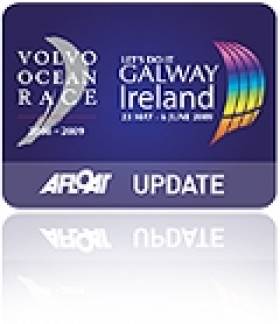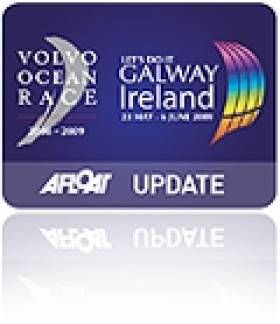Displaying items by tag: Volvo
Puma Retires After Dismasting
The team has recovered all pieces of the mast and all sails from the water. They are currently headed toward the island of Tristan da Cunha.
"We've just withdrawn from the leg," said skipper Ken Read. "We have [the mast] jury rigged – we have about 15 feet of mast left. We have our trysail and storm jib awkwardly set. We're supplementing that with really low revs of the engine just to make forward progress.
"As you can imagine, there aren't a lot of smiles right now, but one way to make it even worse would be to proclaim that there wasn't a chance to make the next leg.
"This is about earning points in this race. We think by sacrificing points on this first leg, it gives us a chance to actually earn points for the second leg and the In-Port Race. So, that's our goal.
"We have all of our fantastic PUMA shore team, the BERG team and of course Volvo all trying to sort it out right now, giving us the help that we need to get to Cape Town in order to make repairs and be ready for the next leg."
PUMA was in second position in the first leg of the race, sailing from Alicante, Spain, to Cape Town when the mast broke. The causes of the dismasting are not known at this stage.
PUMA Ocean Racing's shore team is working on a recovery plan to ensure the yacht can rejoin the race as soon as practically possible and will work closely with Volvo Ocean Race to determine the cause of the dismasting.
Volvo Ocean Race control is in contact with the team to establish the full extent of the damage and ensure the crew are given full support to enable them to deal with the situation.
Disaster Strikes as Puma Dismasted in Volvo Ocean Race
The rig onboard PUMA's Mar Mostro failed at around 15:00 UTC in the southern Atlantic Ocean, about 2,150 nautical miles from Cape Town, South Africa.

Puma crew try to retrieve the broken rig. Photo: Amory Ross/PUMA Ocean Racing/Volvo Ocean Race
Skipper Ken read reported: "We were sailing on a port tack, beam reaching in 22-23 knots of breeze, heading east northeast with eight to 10 foot waves when the mast failed. There were no warning signs.
"There was no panic onboard, and all crew are safe and well.
"Thanks to amazing seamanship, the three pieces of the mast and all of the sails were recovered. We haven't suspended racing at this point and are weighing up our options.
"At this point we are not using our engine, but are taking some time to clear our heads and evaluate next steps. Our plans may include heading to the island of Tristan da Cunha – about 700 nautical miles from us, nearly on the way to Cape Town.
"This is the saddest and most disappointed 11 people on earth. We were in a comfortable second position, traveling south to get into the final front and head across the southern Atlantic towards Cape Town.
"We were planning to be there in five days. At this stage, my goal is to make sure we get this crew back safely and we will look at options as to how to get back in this race."
The Brazilian search and rescue organization have been informed and are on standby to assist if necessary.
PUMA Ocean Racing's shore team is working on a recovery plan to ensure the yacht can rejoin the race as soon as practically possible and will work closely with Volvo Ocean Race to determine the cause of the dismasting.
Volvo Ocean Race control is in constant contact with the team to establish the full extent of the damage and ensure the crew are given full support to enable them to deal with the situation.
The causes of the dismasting are not known at this stage. However, the rig is of a different origin and manufacture to that of Abu Dhabi Ocean Racing's Azzam which suffered a failure earlier during Leg 1.
Further information will be issued as it becomes available.
Heineken Join Galway's Volvo Ocean Race –Video here!
#VOLVO OCEAN RACE – As plans progress to celebrate the end of the Volvo Ocean Sailing Race in Galway next June Heineken has won the pouring rights and the brewer is expecting to serve over one and a half million people during the course of the event.
They're expecting to attract over 200,000 people per day, for each of the eight days. The world race concludes with an In-Port Race and Pro-Am Race and the Prize Giving Ceremony. Thirsty work? Here's hoping! And Here's Heineken's promo video courtesy of youtube with VOR racer Jerry Kirby comparing the last Galway stopver to 'Woodstock'.
Chinese Irish Entry Announces Leg One Retirement
Mike Sanderson, CEO/Skipper of Team Sanya, spent time today elaborating on the events at sea on the morning of Sunday 6th November, and the team's intention to get back in the race as quickly as possible,
"We were moving along nicely and very happy with our progress, managing the big breeze and waves very nicely, we were not pushing 100% and had decided to throttle back a knot or so given the conditions; we felt we were in a comfortable zone. I had just had a chat with the guys when we suddenly felt a very odd lurch, like dragging the keel through soft mud. The guys on deck saw a lot of water coming into the bow and we could also hear the noise of water coming into the bow. The watertight doors were already shut thankfully.
We got everyone up and into lifejackets. For sure if the watertight doors had not been shut, we would have been sunk. We avoided the bear away for a time, which was a pretty tense time, we got the pumps going but they were not really making much difference. After a time our situation stabilized, we were nursing the boat upwind at 4-5 knots and then we bore away, got the jib down and suspended sailing as we headed into port.
Initially we had no idea of the extent of the damage, whether it was a small puncture wound or something larger. We could then see some carbon shards coming off the bow, which we realized were the uni directional fibres peeling back and we then realized the severity of the situation. Once we were at the dock in Motril we could see we had a deal breaker on our hands in terms of not being able to carry on racing from here to Cape Town.
With regard to the injury of our bowman, Andy Meiklejohn, he had an unfortunate bad accident in a completely unrelated incident. We were going through a jib change with Andy on the bow in extremely rough conditions and we had reduced speed from 13 down to around 6/7 knots and were nursing her through the waves. We were then hit by a series of massive waves (most likely the same ones that brought down the Abu Dhabi rig). Andy came down badly on his ankle/foot and sustained an injury. We contacted Race Office but were not sure of the breakage at that time. One hour later we were headed for shore due to the bow damage and so thankfully we were able to get him to the local hospital to be assessed where they confirmed he had indeed broken his foot. Andy is now in the process of receiving medical advise and will be treated asap.
Andy is an extremely pivotal team member and will be sorely missed while he is off. We will asses his recovery time and look at our Plan B for a replacement should we need one.
We are now 100% focused on getting the boat to Cape Town as soon as possible that would leave us 8-9 days in Cape Town before the start. Our worst-case scenario is that we ship to Cape Town but then we don't have time to fix it in time so we are late starting from Cape Town and then miss the ship from our stop point during leg 2.
This is no small task, we have a chop out a 6m x 3m x 1m section of the boat and replace it – normally a 2-3 week job shoehorned into 7 days. But this is the Volvo Ocean Race and we will do what we have to do to make it happen.
One fact that gives me some peace is that damage was not caused by anything we did wrong. For sure I have to believe that we hit something that caused the initial puncture wound that then peeled backwards. We were performing well and in good shape, we have not incurred one other bit of damage in those 24 hours so that is good news.
We need to take the time to do some serious thinking and planning, assessing the logistical options and making the right choices that get us back in the race as soon as possible. We need to repair the hull perfectly; a rush job is not an option.
From a personal point of view I have never before retired from a Whitbread or Volvo leg and so it's a pretty sad moment. We were very comfortable with how we were sailing and so it's extremely disappointing for the guys. Looking back on it we wouldn't do anything differently than we did so it's a good feeling that we handled the situation well.
For us as a team, we can still absolutely achieve everything we have set out to do – win some podium positions and take a few scalps from the other teams – and we fully intend to do that still. It is tragic to be out of this leg for sure but perhaps it would have been more tragic for one of the teams focusing on the overall event win.
Accidents do happen and now its all about the tenacity and focus to get it right, we don't give up, we're all dying to get back into the race, it was gut wrenching getting off the boat in Motril and seeing a big part of the boat missing.
Nothing about this team is reckless, we're not quitters or unprofessional in any way, we have a great bunch of guys here and I have absolute confidence that we will get back on the race track as soon as we possibly can. For now it's a full frenzy of activity to get our Sanya Lan race boat on a ship this Friday and turn a boat building job of 2-3 weeks into 7 days!"
Team Sanya will confirm shipping route and dates of departure and arrival into Cape Town as soon as that information is confirmed to them.
Sanya Hull Damage First Photos Here!
#SANYA HULL DAMAGE – Team Sanya crew were driven back to Alicante to the team hotel they have called home for the past few weeks. For most, their families are still here. The damage to the boat is plain for all to see.
Team Sanya are weighing up the different options available to them which include repairing the boat in Spain or shipping her directly to Cape Town and carry out the repairs there. A final decision will be made later today.
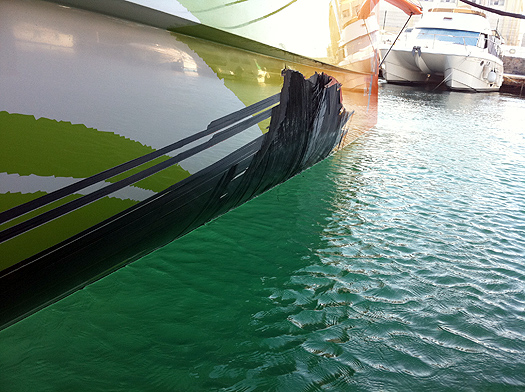
Above and below Sanya's smashed hull - Photo: Team Sanya
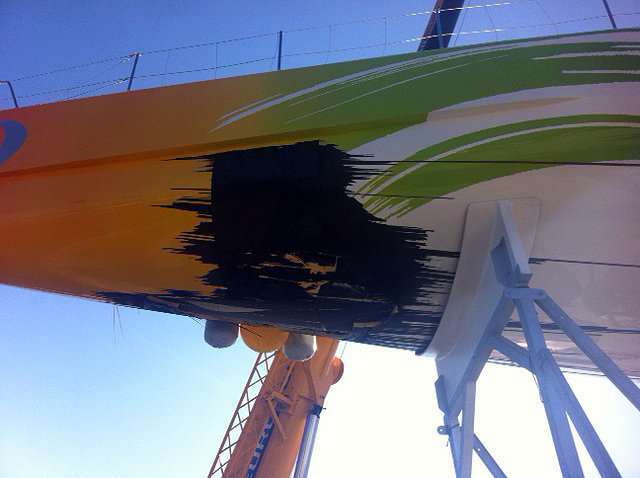
In a completely separate incident during a dramatic sail change yesterday, Team Sanya Bowman Andy Meiklejohn sustained an injury to his foot. He has now had the time to have that injury assessed and the hospital have indeed confirmed that he has broken his foot.
The hope is Andy's foot will have healed and be strong enough to be onboard for the 11th December start of Leg 2.
Emotional Walker Tells How Mast Broke (Video)
#ABU DHABI DISMASTING – "I knew there were going to be problems because my feet left the deck" skipper Ian Walker describes the moment of impact when his Abu Dhabi yacht hit a huge wave and lost its mast in the first hours of the Volvo Ocean Race. The team is back in port and are attempting to rebuild the mast and get going again. Hear the latest from an understandibly emotional Ian Walker dockside here:
Puma Skipper Ken Read heard about the dismasting and has chimed in with his take on the disaster, calling it a 'curse' for winning the first In-Port Race in the Volvo, which Abu Dhabi did.
Two races ago Ericsson won the first In-Port only to have keel ram problems and limped into Cape Horn. Last edition, Telefonica Blue won the first In-Port only to break part of their rudder assembly about an hour into the race and had to go in to port to fix it. Now Abu Dhabi.
Marine Minister Ends Up in Choppy Waters
#VOLVO OCEAN RACE – Ireland's Minister of the Marine Simon Coveney jumped ship on Saturday but it was no political volte face instead it was the expediency of Team Sanya's Captain Mike Sanderson who jettisoned the Fine Gael Cabinet Minister shortly after the start of the Volvo Ocean Race in Alicante.

Minister Simon Coveney (left) and Sailing Anarchy Editor Alan Block in good spirits after going overboard from Team Sanya. Photo: Anders Soranio
Onboard Sanya guests for the start on Sanya included Coveney, a racing sailor himself, and Alan Block, Editor of Sailing Anarchy website. After the inshore couple of laps, they had to brave the elements and jump off the boat into the water and both ended up safely on Sanya's team rib.
As it turns out there was no rush and the guests could have sailed on with the Chineses entry. Within hours Sanderson was heading back to shore after suffering hull damage that looks like it's going to take a while to fix.
Coveney got the VIP seat for the race start because Discover Ireland is backing the Team Sanya entry for 25% of the campaign costs. The VOR finishes in Galway next July.
Discover Ireland Backed Yacht Suffers Hull Damage
#VOLVO OCEAN RACE – 24 hours in to the Volvo Ocean Race (VOR) and the fleet is reduced by one third. First Abu Dhabi was dismasted and now news is coming ashore that Team Sanya has suffered hull damage and is heading back for landfall.
Aksel Magdahl, Navigator on-board Team Sanya reported this morning had suffered hull damage on the first leg of the Volvo Ocean Race 2011-12, which began yesterday in Alicante.
The yacht is 25% backed by Irish tourism body Discover Ireland. The damage happened just 24 hours after Ireland's Minister for the Marine Simon Coveney left the boat shorly after the start of the race.
Mike Sanderson, Skipper has confirmed to Volvo Ocean Race Control that "The situation is very much under control, everyone is obviously disappointed but in good spirits as all are safe on-board," he said.
The boat was approximately 30 nautical miles SE of Motril, on the coast of Spain. The wind was blowing 43 plus knots and the waves were around 10.5 metres.
The watertight doors had already been closed as a precaution due to the prevailing conditions and the boat is making its way to Puerto de Motril. After entering flat water, Team Sanya has suspended racing.
Volvo Ocean Race control is in constant contact with the team while establishing the full extent of the damage so that the crew are given full support to enable them to deal with the situation.
Team Sanya's shore team are working on a recovery plan to ensure the yacht can rejoin the Volvo Ocean Race as soon as practically possible.
1300 hours Sunday: Mike Sanderson, CEO/Skipper of Team Sanya, updates us on the latest situation and his thoughts:So close to making it through the worst of the big breeze and then disaster struck. We were looking after the boat nicely when at approx 0900 this morning while going upwind in 35 knots of wind, suddenly the boat went really bow down and immediately we knew it wasn't good. Instantly we slowed the boat right down, got the remainder of the guys in their bunks into life jackets and then set about tacking over to head for shelter.
The water tight bulkhead is doing a great job, the pumps are running and we are nursing the boat with just a double reefed mainsail into port.
Right now we have no idea how major the damage is, we can however see a puncture wound on the port side and streams of carbon peeling off so it isn't good. We are all safe though, as I write this we are just an hour from a safe harbour. The guys are doing a fantastic job, all very positive and working incredibly hard even though you can see the bitter disappointment on all their faces.
Be under no illusion though, we will be back with vengeance.
I will let you all know as soon as we have checked our poor boat out in a few hours...
Marine Minister Showcases Galway at Volvo Race Start
#VOLVO OCEAN RACE – As the Volvo Ocean Race 2011-2012 kicks off tomorrow (5 November) from Alicante in Spain, Minister for Agriculture, Marine and Food Simon Coveney TD joined Tourism Ireland today, at a reception for key Spanish and international media contacts. As previously reported by Afloat.ie this week the event, which took place in the Volvo Ocean Race Village in Alicante, was an excellent opportunity to showcase Galway and Ireland as a fantastic holiday destination, kicking off Tourism Ireland's publicity drive around the world during the nine-month race to reach a huge audience of potential holidaymakers.
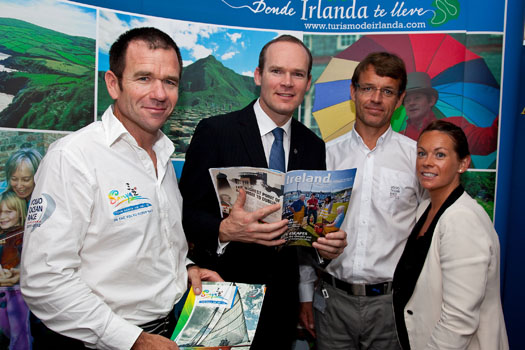
Mike Sanderson, skipper of Team Sanya, the Chinese/Irish boat; Simon Coveney TD, Minister for Agriculture, Marine and Food; Knut Frostad, CEO of the Volvo Ocean Race; and Barbara Wood, Tourism Ireland's manager in Spain, at the Tourism Ireland reception in Alicante, prior to the departure of the Volvo Ocean Race 2011-12 tomorrow
The Volvo Ocean Race attracts huge publicity around the world – with billions of people around the globe seeing it on TV, reading about it and tuning in to hear about it on the radio. Over the coming months, Tourism Ireland will be working in key markets where the race stops, to ensure that Galway and Ireland are in the spotlight.
Niall Gibbons said: "The Volvo Ocean Race attracts huge publicity around the world and with Galway due to host the grand finale, there's an ideal opportunity to showcase Galway and the west, and the many attractions that the island of Ireland has to offer as a holiday destination. The event is a great 'hook' for Tourism Ireland to reach a huge audience of potential holidaymakers."
Galway will host the final stopover of the Volvo Ocean Race 2011-2012 in July of next year. The 2009 stopover of the Volvo Ocean Race in Galway brought 40,500 international visitors to the city, as well as 269 journalists from around the world.
Legends on Show in Alicante, Photos by Rick Tomlinson HERE!
#LEGENDS REGATTA –This week's 16-boat 'legend' fleet racing in Alicante is a far throw from the six-pro teams waiting for this weekend's VOR start proper but everyone in the Spanish port knows that it is the cross-section of old ketches to International Offshore Rule (IOR) designs and right up to the 70-foot sleds of the present era is what has given birth to the modern €10 million race.
Ireland is featuring prominently in this 'oldies' race. Although there's no sign of NCB Ireland from 25 years ago there's plenty of Irish sailors in attendance for a proper celebration with Joe English, Harry Cudmore, Killian Bushe, Bob McCarthy and Enda O'Coineen leading the charge.
Rick Tomlinson's stunning photos of the Legend's regatta are below.


























